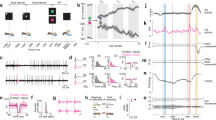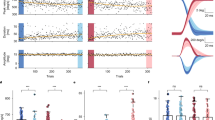Abstract
Purkinje cells of the cerebellum discharge complex spikes, named after the complexity of their waveforms1, with a frequency of ∼1 Hz during arm movements1,2,3,4,5,6,7,8,9,10,11,12,13. Despite the low frequency of firing, complex spikes have been proposed to contribute to the initiation of arm movements2,7,8,9,10 or to the gradual improvement of motor skills2,4,5,6,14,15,16. Here we recorded the activity of Purkinje cells fromthe hemisphere of cerebellar lobules IV–VI while trained monkeys made short-lasting reaching movements (of ∼200 milliseconds in duration) to touch a visual target that appeared at a random location on a tangent screen. We examined the relationship between complex-spike discharges and the absolute touch position, and between complex-spike discharges and relative errors in touching the screen. We used information theory to show that the complex spikes occurring at the beginning of the reach movement encode the absolute destination of the reach, and the complex spikes occurring at the end of the short-lasting movements encode the relative errors. Thus, complex spikes convey multiple types of information, consistent with the idea that they contribute both to the generation of movements and to the gradual, long-term improvement of these movements.
This is a preview of subscription content, access via your institution
Access options
Subscribe to this journal
Receive 51 print issues and online access
$199.00 per year
only $3.90 per issue
Buy this article
- Purchase on Springer Link
- Instant access to full article PDF
Prices may be subject to local taxes which are calculated during checkout




Similar content being viewed by others
References
Thach, W. T. Discharge of Purkinje and cerebelar nuclear neurons during rapidly alternating arm movements in the monkey. J. Neurophysiol. 31, 785–797 (1968).
Simpson, J. I., Wylie, D. R. & De Zeeuw, C. I. On climbing fiber signals and their consequence(s). Behav. Brain Sci. 19, 384–398 (1996).
Thach, W. T. Discharge of cerebellar neurons related to two maintained postures and two prompt movements. II. Purkinje cell output and input. J. Neurophysiol. 33, 537–547 (1970).
Gilbert, P. F. C. & Thach, W. T. Purkinje cell activity during motor learning. Brain Res. 128, 309–328 (1977).
Keating, J. G. & Thach, W. T. Nonclock behavior of inferior olive neurons: interspike interval of Purkinje cell complex spike discharge in the awake behaving monkey is random. J. Neurophysiol. 73, 1329–1340 (1995).
Thach, W. T. On the specific role of the cerebellum in motor learning and cognition: clues from PET activation and lesion studies in man. Behav. Brain. Sci. 19, 411–431 (1996).
Mano, N., Kanazawa, I. & Yamamoto, K. Complex-spike activity of cerebellar P-cells related to wrist tracking movement in monkey. J. Neurophysiol. 56, 137–158 (1986).
Mano, N., Kanazawa, I. & Yamamoto, K. Voluntary movements and complex-spike discharges of cerebellar Purkinje cells. Exp. Brain. Res. 17, 265–280 (1989).
Bauswein, E., Kolb, F. P., Leimbeck, B. & Rubia, F. J. Simple and complex spike activity of cerebellar Purkinje cells during active and passive movements in the awake monkey. J. Physiol. 339, 379–394 (1983).
Wang, J. J., Kim, J. H. & Ebner, T. J. Climbing fiber afferent modulation during a visually guided multi-joint arm movement in the monkey. Brain Res. 410, 323–329 (1987).
Ojakangas, C. L. & Ebner, T. J. Purkinje cell complex and simple spike changes during a voluntary arm movement learning task in the monkey. J. Neurophysiol. 68, 2222–2236 (1992).
Ojakangas, C. L. & Ebner, T. J. Purkinje cell complex spike activity during voluntary motor learning: relationship to kinematics. J. Neurophysiol. 72, 2617–2630 (1994).
Fu, Q. G., Mason, C. R., Flament, D., Coltz, J. D. & Ebner, T. J. Movement kinematics encoded in complex spike discharge of primate cerebellar Purkinje cells. Neuroreport 8, 523–529 (1997).
Ito, M. The Cerebellum and Neural Control (Raven, New York, (1984)).
Kawato, M. & Gomi, H. Acomputational model of four regions of the cerebellum based on feedback-error learning. Biol. Cybern. 68, 95–103 (1992).
Houk, J. C., Buckingham, J. T. & Barto, A. G. Models of the cerebellum and motor learning. Behav. Brain Sci. 19, 368–383 (1996).
Arbib, M. A. Spanning the levels in cerebellar function. Behav. Brain Sci. 19, 434–435 (1996).
Kitazawa, S., Kohno, T. & Uka, T. Effects of delayed visual information on the rate and amount of prism adaptation in the human. J. Neurosci. 15, 7644–7652 (1995).
Abeles, M. & Goldstein, M. H. Multiple train analysis. Proc. IEEE 65, 762–773 (1977).
Acknowledgements
We thank F. A. Miles and K. Kawano for comments on the manuscript; M. Okui for technical assistance; K. Kurata for useful advice; and S. Yamane and R. Suzuki for encouragement during this study.
Author information
Authors and Affiliations
Corresponding author
Rights and permissions
About this article
Cite this article
Kitazawa, S., Kimura, T. & Yin, PB. Cerebellar complex spikes encode both destinations and errors in arm movements. Nature 392, 494–497 (1998). https://doi.org/10.1038/33141
Received:
Accepted:
Issue Date:
DOI: https://doi.org/10.1038/33141
This article is cited by
-
Emergence of syntax and word prediction in an artificial neural circuit of the cerebellum
Nature Communications (2024)
-
Underlying interactive neural mechanism of motor learning governed by the cerebellum, the basal ganglia, and motor/sensory cortex: a review from theoretical perspective
Neuroscience and Behavioral Physiology (2024)
-
Cerebellar climbing fibers multiplex movement and reward signals during a voluntary movement task in mice
Communications Biology (2023)
-
Divisively normalized neuronal processing of uncertain visual feedback for visuomotor learning
Communications Biology (2023)
-
Cerebellar associative learning underlies skilled reach adaptation
Nature Neuroscience (2023)
Comments
By submitting a comment you agree to abide by our Terms and Community Guidelines. If you find something abusive or that does not comply with our terms or guidelines please flag it as inappropriate.



